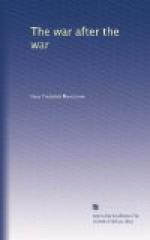“What can we do to stem this tide of extravagance and at the same time plant the seed of permanent thrift,” asked these men who ranged from Premier to Prelate. No one knew better than they the difficulties of the task before them. In England, as in America, thrift is more regarded as a vice than a virtue. Like the taste for olives it is an acquired thing. To spend, not to save, is the instinct of the race.
But there were other and equally serious reasons why all England should buck up financially and make every penny do more than its duty. First and foremost was the terrific cost of the war that every day took its toll of $25,000,000; second was the enormous increase in imports and the diminished flow of exports, a reversal of pre-war conditions that meant that England each day was buying $5,000,000 worth of goods more than other countries were purchasing from her; third was the human shrinkage due to the incessant demand of battlefield and factory. Everywhere was colossal expenditure of men and money: nowhere existed check or restraint. Something had to be done.
It was generally admitted that the first thing for everybody to do was to spend less on themselves than in times of peace. When, where and how to save became the great question. To save money at the cost of efficiency for essential and urgent work was not true economy. “But,” said the thrift promoters, “waste is possible even in the process of attaining efficiency. For example, people may eat too much as well as too little, they may buy more clothes than they actually need, ride when they could walk, employ a servant when they could do their own work, use their motors when they could travel in a tram.”
Thus every class came within the range of the lightning that was about to strike at the root of an ancient evil.
The start was interesting. Before the war was a year old definite order emerged of what was at the beginning a scattered protest against reckless spending. But long before the first organised message of saving went to the home and purse of the worker, the rich began to economise. Here is where you encounter the first of the many ironies and contrasts that mark this whole campaign. The people who could most afford to be extravagant were the first to draw in their horns. This, of course, was not particularly surprising because the rich are naturally thrifty. It is one reason why they get and stay rich.
Among the pioneer organisations was the Women’s War Economy League founded and developed by a group of titled women who got hundreds of their sisters to pledge themselves to give up unnecessary entertaining, not to employ men servants unless ineligible for military service, to buy no new motor cars and use their old ones for public or charitable work, to buy as few expensive articles of clothing as possible, to reduce in every way their expenditures on imported goods, and to limit the buying of everything that came under the category of luxuries. Champagne was banned from the dinner table, decollete gowns disappeared: men substituted black for white waistcoats in the evening.




